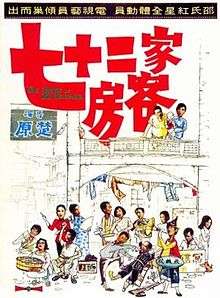The House of 72 Tenants
The House of 72 Tenants (七十二家房客) is a 1973 Hong Kong film directed by Chor Yuen. It is a remake of a 1963 Chinese film of the same name. It was the top box office film of 1973 in Hong Kong, surpassing Bruce Lee's Enter the Dragon.[1]
| The House of 72 Tenants | |
|---|---|
 Original Hong Kong Poster | |
| Chinese | 七十二家房客 |
| Mandarin | Qī Shǐ Èr Jiā Fáng Ké |
| Cantonese | Cat1 Sap6 Ji6 Gaa1 Fong4 Haak3 |
| Directed by | Chor Yuen |
| Produced by | Run Run Shaw Andrew Au |
| Written by | Chor Yuen |
| Starring | Elliot Ngok Adam Cheng Woo Gam Ching Li Lydia Shum Ivan Ho |
| Music by | Frankie Chan |
| Cinematography | Wong Chit |
| Edited by | Chiang Hsing Lung |
Production company | |
| Distributed by | Shaw Brothers Studio |
Release date |
|
Running time | 98 minutes |
| Country | Hong Kong |
| Language | Cantonese |
| Box office | HK$ 5,626,675.20 |
The 72 inhabitants of a dilapidated tenement live under the thumb of a heartless landlady and her buffoonish husband. The arrival of a defiant new tenant, the cobbler Fat Chai, sets their downfall in motion. The residents pool their resources to prevent evictions, deflect targeted harassment by a corrupt policeman, rescue the landlords' adopted daughter from a life of torment, and ultimately prevent their home from being sold and turned into a brothel.
Cast
- Ouyang Sha-fei
- Chan Shen - Brother Shum
- Adam Cheng
- Cheng Hong-Yip
- Cheng Kang
- Chen Kuan Tai - Police Constable (cameo)
- Ching Miao
- Chor Yuen - thief in market (cameo)
- Chung Hwa
- Do Ping
- Got Dik Wa
- Lily Ho
- Ivan Ho
- Hu Ching
- Ricky Hui
- Ku Feng
- Lau Tan
- Law Lan
- Cheng Lee - Ah Heung (credited as Ching Li)
- Danny Lee
- Lee Sau Kei
- Leung Tin
- Liu Hui-Ling
- Nan Hong
- Peng Peng
- Sai Gwa-pau
- Shih Szu
- Lydia Shum - Shanghai Po
- Tien Ching - Chow Bing Ken
- Betty Pei Ti
- Wang Chung (actor)
- Wong Ching-Ho
- Wong Kwong Yue
- Karen Yeh - Mrs. Han
- Yeung Chak Lam
- Elliot Ngok - Fat Chai
Special notes
The House of 72 Tenants can be considered to have started a new era for Hong Kong film industry. Before the release of this movie, most high-class movies filmed in the then British colony were shot and recorded in Mandarin, while the less respected ones would be shot and recorded in Cantonese. However, since the debut of the movie, which was filmed in Cantonese, and the popularity it achieved, subsequent major Hong Kong films switched their language from Mandarin to Cantonese.
Parodies
Parodies of this movie are found in many of Hong Kong's films and Television shows.
In movies:
- He Ain't Heavy, He's My Father: Chor Yuen, the director for The House of 72 Tenants is part of the cast.
- Kung Fu Hustle
In TV shows:
- Enjoy Yourself Tonight: Where Lydia Shum continues to play the role of 'Shanhai-por' from this movie.
See also
References
- Gary G. Xu, Sinascape: Contemporary Chinese Cinema (Rowman & Littlefield, 2007), 91